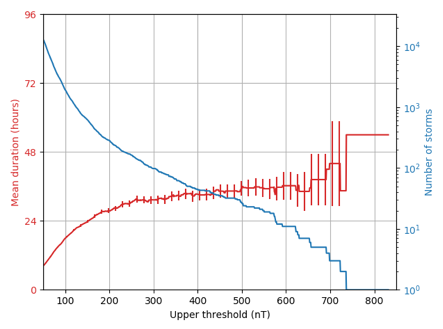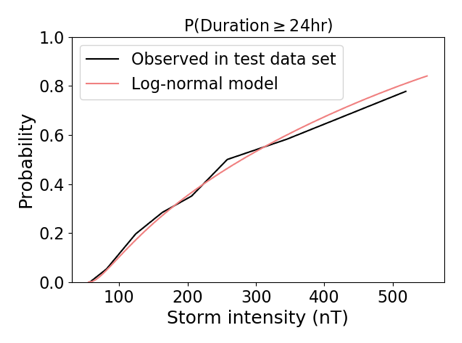MIST
Magnetosphere, Ionosphere and Solar-Terrestrial
The Variation of Geomagnetic Storm Duration with Intensity
By Carl Haines (University of Reading)
Variability in the near-Earth solar wind conditions can adversely affect a number of ground- and space-based technologies. Some of these space weather impacts on ground infrastructure are expected to increase primarily with geomagnetic storm intensity, but also storm duration, through time-integrated effects. Forecasting storm duration is also necessary for scheduling the resumption of safe operating of affected infrastructure. It is therefore important to understand the degree to which storm intensity and duration are related.
In this study, we use the recently recalibrated aa index, aaH, which provides a global measure of the level of geomagnetic disturbance. We analyse the relationship between geomagnetic storm intensity and storm duration over the past 150 years, further adding to our understanding of the climatology of geomagnetic activity. In particular, we construct and test a simple probabilistic forecast of storm duration based on storm intensity. Using a peak-above-threshold approach to define storms, we observe that more intense storms do indeed last longer but with a non-linear relationship (See Figure 1a).


Figure 1 (a) The mean duration (red) and number of storms (blue) plotted as a function of storm intensity. (b) The probability that a storm will last at least 24 hours plotted as a function of storm intensity. The black line shows the observed probability and the red line shows the model output.
Next, we analysed the distribution of storm durations in different intensity classes. We found them to be approximately lognormal, with parameters depending on the storm intensity. On this basis we created a method to probabilistically predict storm duration given peak intensity. Equations are given to find lognormal parameters as a function of storm peak intensity. From these, a distribution of duration can be created and hence a probabilistic estimate of the duration of this storm is available. This can be used to predict the probability a storm will last at least e.g. 24 hours. Figure 1b shows the output of the model for a range of storm peak intensity compared against a test set of the aaH index. The model has good agreement with the observations and provides a robust method for estimating geomagnetic storm duration. The results demonstrate significant advancements in not only understanding the properties and structure of storms, but also how we can predict and forecast these dynamic and hazardous events.
For more information, please see the paper:
Haines, C., Owens, M.J., Barnard, L. et al. Sol Phys (2019) 294: 154. https://doi.org/10.1007/s11207-019-1546-z